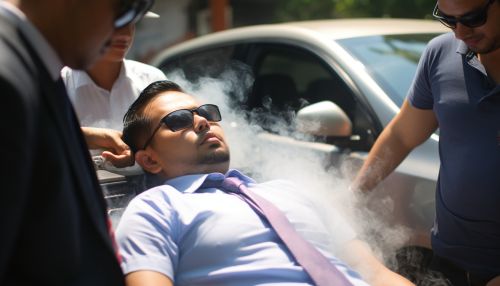Heat Stroke
Introduction
Heat stroke, also known as sunstroke, is a type of severe heat illness that results in a body temperature greater than 40.0 °C (104.0 °F) and confusion. Other symptoms include red, dry or damp skin, headache, and dizziness. Onset can be sudden or gradual. Complications may include seizures, rhabdomyolysis, or kidney failure.
Heat stroke is caused by heat stress, such as from exercise or high temperatures. Risk factors include heat waves, high humidity, certain drugs such as diuretics, beta blockers, or alcohol. Diagnosis is based on symptoms. It is a type of hyperthermia. It is distinct from fever, in which there is a physiological increase in the temperature set point.
Prevention includes drinking sufficient fluids and avoiding excessive heat. Treatment includes rapid cooling of the body and supportive care. Heat stroke is a medical emergency. With treatment the risk of death is less than 5%; without it can be greater than 50%.


Causes
Heat stroke generally occurs as a progression from milder heat-related illnesses such as heat cramps, heat syncope (fainting), and heat exhaustion. However, it can strike even if you have no previous signs of heat injury.
Heat stroke results from prolonged exposure to high temperatures -- usually in combination with dehydration -- which leads to failure of the body's temperature control system. The medical definition of heat stroke is a core body temperature greater than 104 degrees Fahrenheit, with complications involving the central nervous system that occur after exposure to high temperatures. Other common symptoms include nausea, seizures, confusion, disorientation, and sometimes loss of consciousness or coma.
Risk Factors
Anyone can develop heat stroke, but several factors increase your risk:
- Age. Infants and children up to age 4, and adults over age 65, are particularly vulnerable because they adjust less easily to changes in temperature. Also, they are the most likely to have a chronic medical condition that changes normal body responses to heat, or to take medication that affects the body's ability to stay hydrated and sweat.
- Certain health conditions. These include heart, lung, or kidney disease, obesity or underweight, high blood pressure, diabetes, mental illness, sickle cell trait, alcoholism, sunburn, and any conditions that cause fever. People with these conditions need to be especially cautious in the heat.
- Medications. Some medications affect your body's ability to stay hydrated and respond to heat. Be especially careful in the heat if you take medications that narrow your blood vessels (vasoconstrictors), regulate your blood pressure by blocking adrenaline (beta blockers), rid your body of sodium and water (diuretics), or reduce psychiatric symptoms (antidepressants or antipsychotics). Stimulants for attention-deficit/hyperactivity disorder (ADHD) and illegal stimulants such as amphetamines and cocaine also make you more vulnerable to heat stroke.
- A previous heat stroke. If you've experienced heat stroke once, you're at a higher risk of a future heat stroke.
Symptoms
Heat stroke symptoms can vary from person to person, but may include:
- An elevated body temperature of 104 F (40 C) or higher - Skin that feels hot and dry, but not sweaty - Throbbing headache - Dizziness and light-headedness - Lack of sweating despite the heat - Red, hot, and dry skin - Muscle weakness or cramps - Nausea and vomiting - Rapid heartbeat, which may be either strong or weak - Rapid, shallow breathing - Behavioral changes such as confusion, disorientation, or staggering - Seizures - Unconsciousness
Diagnosis
Heat stroke is generally diagnosed by observation of the symptoms and signs noted above. However, a doctor may also use other diagnostic tests, such as:
- A blood test to check for low blood sodium or potassium and the content of gases in your blood to see if there's been damage to your central nervous system. - A urine test to check the color of your urine, because if it's darker than usual, you might be dehydrated. - Muscle function tests to check for serious damage to your muscle tissue (rhabdomyolysis). - X-rays and other imaging tests to check for damage to your internal organs.
Treatment
Treatment involves cooling the body to a normal temperature to prevent or reduce damage to the brain and vital organs. To do this, doctors may:
- Immerse you in a bath of cold water - Use evaporation cooling techniques - Pack you with ice and cooling blankets - Give you medications to stop your shivering, which can increase your body temperature
In addition to the measures above, your doctor will monitor your heart and blood pressure, and may give you other treatments to prevent or treat complications.
Prevention
Prevention is the best way to deal with heat stroke. Some strategies include:
- Wearing lightweight, light-colored, loose-fitting clothing and a wide-brimmed hat. - Using a sunscreen with a sun protection factor (SPF) of 30 or more. - Drinking extra fluids. To prevent dehydration, it's generally recommended to drink at least eight glasses of water, fruit juice, or vegetable juice per day. - Taking additional precautions with certain medications. Be on the lookout for heat-related problems if you take medications that can affect your body's ability to stay hydrated and dissipate heat. - Never leaving anyone in a parked car. This is a common cause of heat-related deaths in children. When parked in the sun, the temperature in your car can rise 20 degrees F (more than 6.7 C) in 10 minutes.
See Also
- Heat Illness - Heat Cramps - Heat Exhaustion - Hyperthermia
